Time is ticking and there’s no way to stop it.
I always realize this when a deadline looms and it seems like everything is moving in the slowest of motion and there’s no noticeable progress on anything, anywhere.
Time is ticking. There is no way to stop it.
To be comfortably finished with this goldwork altar cover, we’ve got 34 days. Will we make it? I don’t know. But we’re giving it our best!
We can add five days and be finished at the Absolutely Deadline, but I’d rather say we have 34 days and keep that in my head, because I don’t want to be frantically scurrying at the Absolute Deadline. I want to be able to breathe a bit at the very end of the project.
Now, there may be no way to stop time from ticking away, but there are ways to speed up processes, to make more of your time – even if it’s just in the tiniest of ways. It all adds up!
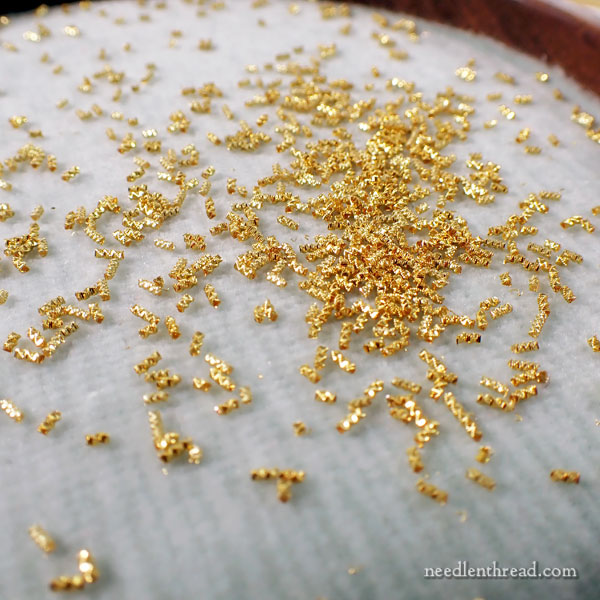
We’re still on the chip work on the lettering for this project! Good Golly… it’s slow going.
I absolutely love the look of random chipping on goldwork (I love sparklies!), but it is one of the slower methods of filling large spaces in goldwork.
I learned early on in this project to cut a boatload of chips at one time. To stop to cut little chips frequently will drive you nuts if you have to sew on some gazillion-sixty-thousand-million chips.
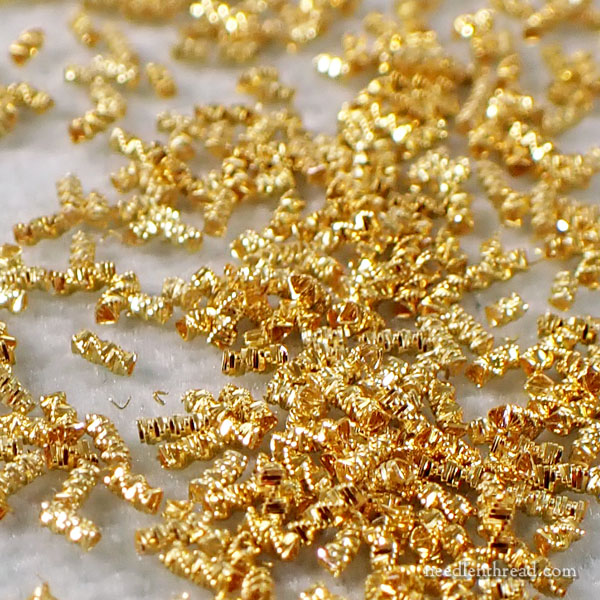
We’re using a #10 bright check purl, which is a small (the smallest, I believe) purl.
Purl is a “thread” that’s actually more of a tube that’s similar to a spring (only it doesn’t spring back if you stretch it), made from the tiniest gold wire. There are different kinds: smooth, rough, and check. On smooth and rough purl, the tube is smooth and it looks round if you look inside the tube.
With bright check purl, the tube is faceted, and it looks like a twisted triangle if you look inside the tube. In the close-up above, you can see the open ends of the faceted chips.
The resulting random chip work in bright check purl is Very Sparkly Indeed.
To use purl, you cut the longer snake of purl into small pieces that you sew on to the fabric like beads, using a waxed thread.
Time-saving tip #1: Prepare your materials in advance! In this case, cut a heap of those little chips before you start your stitching session! I try to cut enough to take me through one whole letter.
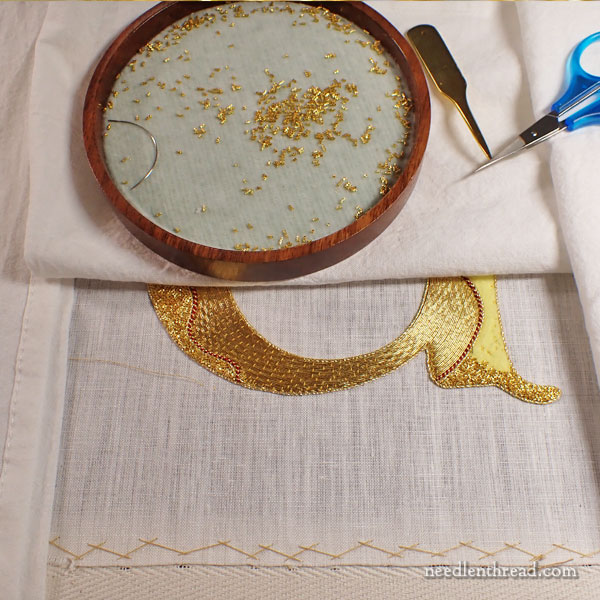
Yesterday around 10:00 AM, I began on the lower right of the U that you can see peeking out under the cloths in the photo above.
I had finished the chip work on the left side of the U the day before, after it had languished for a couple weeks since the last time I could get to it.
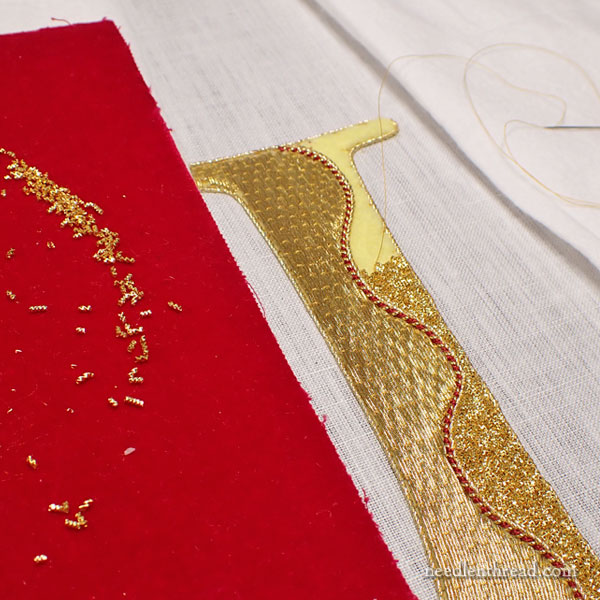
While I normally use the round wood trays that you see in a lot of the photos on this project – they have a small lip on them of about 1 centimeter deep on the inside – I decided yesterday to dump my chips onto a velvet board with no lip. I could get the velvet board right up on top of the goldwork, practically, and I found that it was easier and faster to pick up the chips without working around the lip on the tray.
I love the wooden trays, and I will continue using them, but when I’m in a gosh-awful hurry, I think I’ll go lipless from now on.
Time-saving tip #2: use the most efficient tools, which are not always necessarily the prettiest tools!
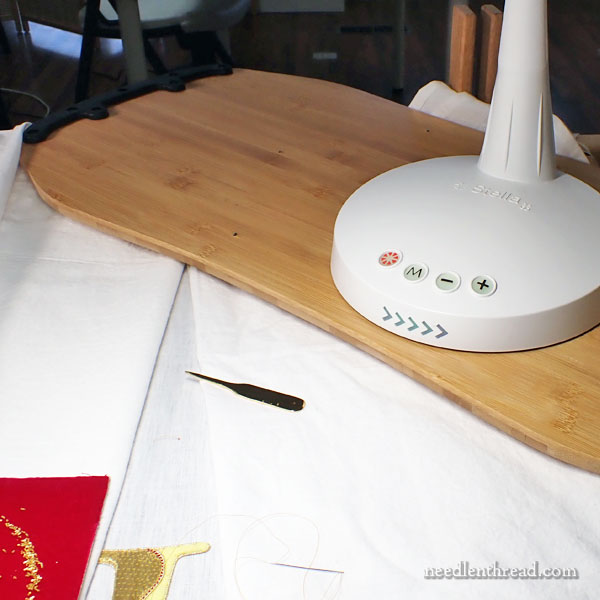
And then there’s this!
Ever since we started this project, I have been fiddling with my light and where it is placed. Because of the width of the frame that we are working on, I have a hard time getting light where I want it over my embroidery area.
On this project, I like to use the lamp in the photo above – which I’m going to review in depth very soon – because it is light and easily moveable and it gives off great light. But… with the width of the frame, I have to rig something to be able to get the light close to where I need it.
And for months and months, I have spent time moving that light here and there and everywhere, balancing it on this and that, and trying to make something work on top of the frame for holding the light.
You’d think I would have gone somewhere and gotten a board made or something. And that was my intention. But I never thought of it ahead of time – only when I was struggling with the light.
Finally, yesterday, after trying to use a rigid plastic container lid across the top of the frame (stretching from roller to roller), and the container lid dipping down onto the fabric (which is what you don’t want to happen), and the light sliding on the lid, and then trying to balance the lamp on the slats on the side of the frame, and then the lamp falling backwards and then the lamp falling forwards, after constantly trying to steady it and to move not tooooo much so it wouldn’t lose balance… I lost it.
The straw broke, and I expressed my frustration loudly for all to hear (that would be Anna) in somewhat unladylike terms.
Why haven’t I gotten a riffemrackemfrickemfrackem board for this riffemrackemfrickemfrackem light yet?!?!
I was really frustrated.
So we cast our eyes around the studio, desperately seeking a reasonable and quick solution.
Suddenly, Anna said with a smirk, Well, you could use THIS.
“THIS” is a Motion X Rocker Board that came with my tables that we use for most of our work.
Now, Anna is not fond of the Motion X Rocker Board the way I’m fond of the Motion X Rocker Board.
I suspect she cringes internally when I take it out and climb aboard.
You see, when I’m on that thing, I can’t help it! I switch on the Beach Boys and practice my sweet surfing moves to Surfin’ USA. And with our huge plate windows facing out to the world going by, I’m guessing she finds it a bit embarrassing.
So of course, I wasn’t surprised when she made the Motion X Rocker Board the victim of her search.
But you know, it was just the right size. And although it is somewhat heavy, it doesn’t touch the surface of the fabric. It’s a very rigid, strong board and it spans the frame well, from roller to roller.
So, with a couple twists of a handy little screw driver, off came the rocker base.
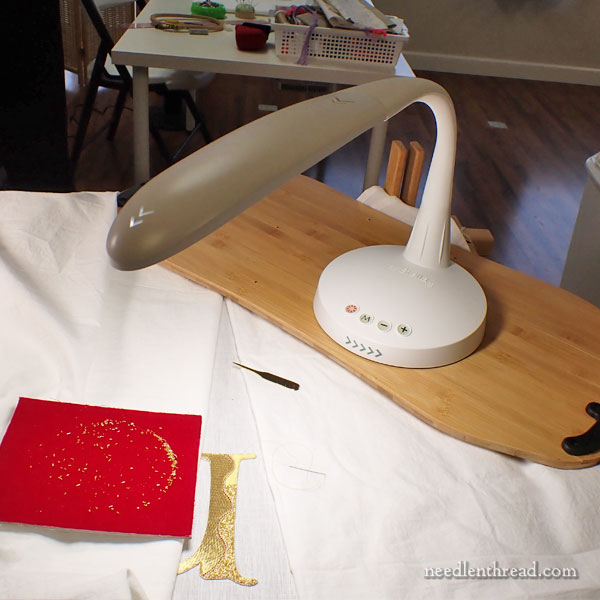
We gave that thing a clean-up, and now I have a fuss-free light station. My light is exactly where I need it, without the constant fiddling that it required before the Great Rocker Board Discovery.
Time-saving tip #3: Situate your work station ahead of time, and get your ducks in a row for lighting, tool placement, and so forth. The less you have to fiddle with the things you need to work with, the better.
I can’t tell you how much time I’ve wasted fiddling with my lighting. And now the problem is solved!
Thank you, Rocker Board!
(I don’t think Anna realizes I kept the screws to the rocker base. My surfing days are not over.)
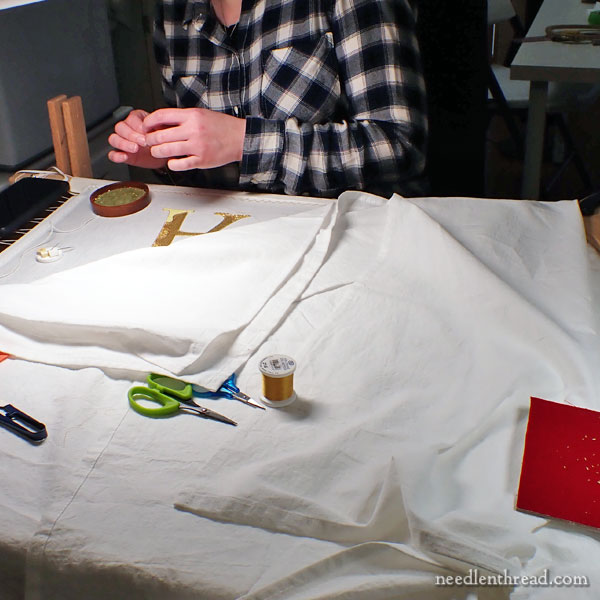
With my lighting situation taken care of, Anna and I both settled down to a quiet afternoon of frenzied chipping.
Anna is working across the frame from me, on an A. I’m on the U on the other side, and I’ll be on the S today.
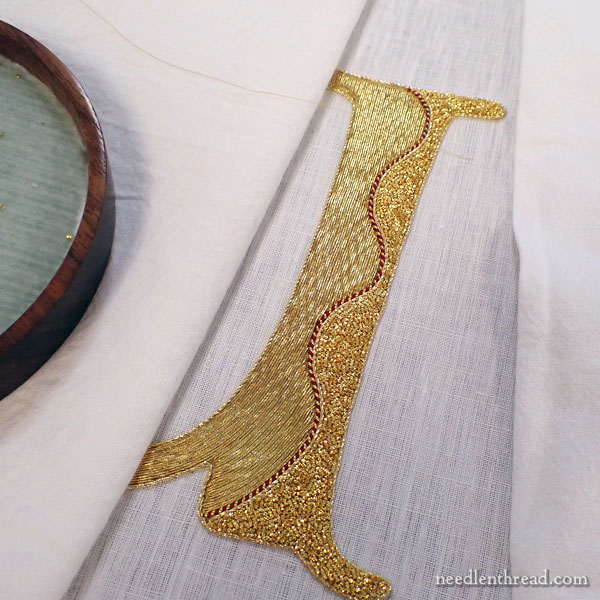
When the clock struck 5:00 PM, I put the last chip on the U. Yay!
That means it takes about 1.5 days, stitching about 6 hours a day (or 12 hours), to do the chip work on one letter, if the letter has approximately the same chip work space as the U. I think the M took the longest – it’s the largest letter, but thankfully, it’s already out of the way.
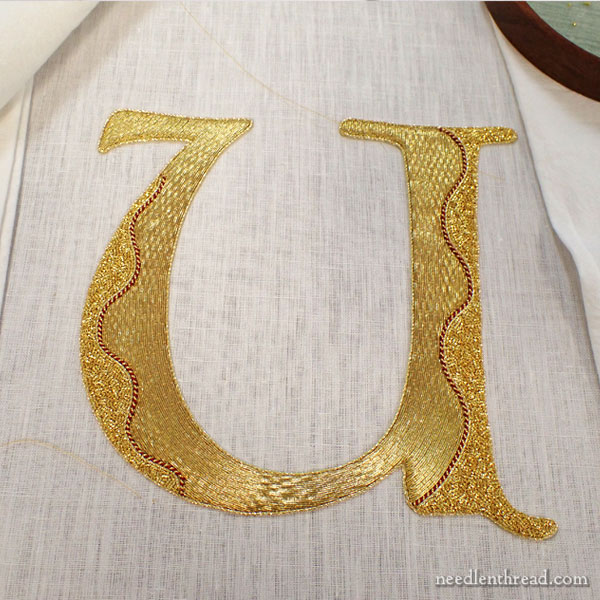
S is next. Here I go!
The Backstory
If you’d like to read about this project and follow along with the updates from its beginning, you can find the index of articles about this goldwork altar cover here.









